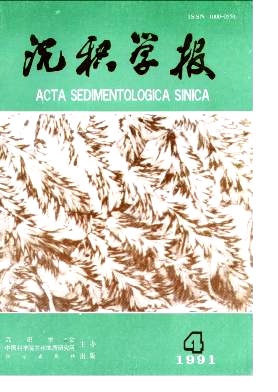Ichnocoenoses of the Late Paleozoic and Mesozoic Fluvial Deposits of Emei Area, Western Sichuan, China
- Received Date: 1989-10-14
- Publish Date: 1991-12-10
Abstract: This paper chiefly deals with the composition, occurrence and sedimentary environments of the three unusually differential ichnocoenoses that are distinguished from the trace fossils well preserved in the Upper Permian, Lower Triassic and Upper Cretaceous fluvial deposits in Emei area. The three ichnocoenoses are recognized: (1)Scoyenia-Rhizoliths ichnocoenosis which occurs in the Shawan Formation (P2), mainly consists of Scoyenia, Planolites, Muensteria, Psammichnites, Skolithos, of. Stipsellus and Rhizoliths (mostly horizontal root casts, diagonal root casts, and partly vertical root casts) and so on, associated with the flood plain deposit that was made up of grey-yellow or green fine-grain sandstones, violet-red siltstones and mudstones as well as less intercalated carbonaceous shales contained plant fossils and thin-bedded coal, it might be explained to be formed in a hot, humid, fluvial environment. (2)Trichichnus ichnocoenosis generated in the second and the third members of the Feixianguan Formation (T2), is an Oppor tunistic ichnotaxa of high abundance and low diversity, i. e. highly concentrated trace fossil of Trichichnus occurs in red thin-bedded fine-grained sandstone, siltstone and muddy siltstone of the flood plain deposits comprising very little other trace fossils of Planolites, Gordia , Skolithos and so forth, which may serve to represent a frequently hot-dry and unstable river environment on the alluvial plain near the sea shore. (3)Scoyenia-Rusophycus ichnocoenosis from Jiaguan Formation (K2), is composed of extraordinarily di-versed and well preserved trace fossils including two different assemblages: Scoyenia-Steinichnus-Rusophycus and Skolithos-Arenicolites. The former contains Fodinichnia, Pascichnia or trails, Repichnia, Cubichnia and some small-patterned Domichnia, of which common ichnogenera are Scoyenia, Cystichnium (ichnogen. nov.), cf. Oniscoidichnus, Monomorphichnus, Pelecypodichnus, Rusophycus and so on, which formed in the flood plain deposits; The latter occurs generally in the channel bar or near shore deposits of the river fades and comprises only Skolithos, Arenicolites as well as other vertical burrows. Most of the trace fossils of this ichnocoenosis are associated with a lot of mudcracks, raindrop imprints, and asymmetrical current ripples on bedding surface of the red fine-grained sandstone, siltstone and mudstone, it is therefore interpreted to be originated in a regularly desiccated fluviatile environment (including extremely shallow lacustrine condition on the flood plain).
| Citation: | Hu Bin, Wu Xiantao, Pan Limin. Ichnocoenoses of the Late Paleozoic and Mesozoic Fluvial Deposits of Emei Area, Western Sichuan, China[J]. Acta Sedimentologica Sinica, 1991, 9(4): 128-135. |






 DownLoad:
DownLoad: